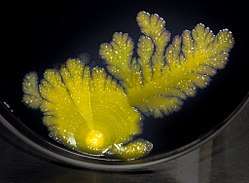Sphingomonas
Sphingomonas was defined in 1990 as a group of Gram-negative, rod-shaped, chemoheterotrophic, strictly aerobic bacteria. They possess ubiquinone 10 as their major respiratory quinone, contain glycosphingolipids (GSLs), specifically ceramide,[2] instead of lipopolysaccharide (LPS) in their cell envelopes, and typically produce yellow-pigmented colonies.[3]
By 2001, the genus included more than 20 species that were quite diverse in terms of their phylogenetic, ecological, and physiological properties. As a result, Sphingomonas was subdivided into different genera: Sphingomonas, Sphingobium, Novosphingobium, Sphingosinicella, and Sphingopyxis. These genera are commonly referred to collectively as sphingomonads. The sphingomonads are widely distributed in nature, having been isolated from many different land and water habitats, as well as from plant root systems, clinical specimens, and other sources; this is due to their ability to survive in low concentrations of nutrients, as well as to metabolize a wide variety of carbon sources. Numerous strains have been isolated from environments contaminated with toxic compounds, where they display the ability to use the contaminants as nutrients.[3]
Some of the sphingomonads (especially Sphingomonas paucimobilis) also play a role in human disease, primarily by causing a range of mostly nosocomial, non-life-threatening infections that typically are easily treated by antibiotic therapy.[4][5]
Due to their biodegradative and biosynthetic capabilities, sphingomonads have been used for a wide range of biotechnological applications, from bioremediation of environmental contaminants to production of extracellular polymers such as sphingans (e.g., gellan, welan, and rhamsan) used extensively in the food and other industries.[6] The shorter carbohydrate moiety of GSL compared to that of LPS results in the cell surface being more hydrophobic than that of other Gram-negative bacteria, probably accounting for both Sphingomonas' sensitivity to hydrophobic antibiotics and its ability to degrade hydrophobic polycyclic aromatic hydrocarbons.[3] One strain, Sphingomonas sp. 2MPII, can degrade 2-methylphenanthrene.[7] In May 2008, Daniel Burd, a 16-year-old Canadian, won the Canada-Wide Science Fair in Ottawa after discovering that Sphingomonas can degrade over 40% of the weight of plastic bags (Polyethylene) in less than three months.[8]
A Sphingomonas sp. strain BSAR-1 expressing a high activity alkaline phosphatase (PhoK) has also been applied for bioprecipitation of uranium from alkaline solutions. The precipitation ability was enhanced by overexpressing PhoK protein in E. coli. This is the first report of bioprecipitation of uranium under alkaline conditions.[9]
References
- LPSN bacterio.net
- Minamino, Miki; Sakaguchi, Ikuyo; Naka, Takashi; Ikeda, Norikazu; Kato, Yoshiko; Tomiyasu, Ikuko; Yano, Ikuya; Kobayashi, Kazuo (2003). "Bacterial ceramides and sphingophospholipids induce apoptosis of human leukaemic cells". Microbiology. 149: 2071–2081. doi:10.1099/mic.0.25922-0. Retrieved 13 May 2018.
- Sphingomonas, Microbewiki
- Ryan MP, Adley CC. "Sphingomonas paucimobilis: a persistent Gram-negative nosocomial infectious organism". J Hosp Infect. 75: 153–7. doi:10.1016/j.jhin.2010.03.007. PMID 20434794.
- Sphingomonas paucimobilis Bloodstream Infections Associated with Contaminated Intravenous Fentanyl, Lisa L. Maragakis, Romanee Chaiwarith, Arjun Srinivasan, Francesca J. Torriani, Edina Avdic, Andrew Lee, Tracy R. Ross, Karen C. Carroll, and Trish M. Perl, Emerging Infectious Diseases Vol. 15, No. 1, January 2009
- Yabuuchi E, Kosako Y (2015). "Sphingomonas". Bergey's Manual of Systematics of Archaea and Bacteria. John Wiley & Sons. doi:10.1002/9781118960608.gbm00924.
- G.M. Ni'matuzahroh; M. Gilewicz; M. Guiliano & J.C. Bertrand (May 1999). "In-vitro study of interaction between photooxidation and biodegradation of 2-methylphenanthrene by Sphingomonas sp 2MPII". Chemosphere. 38 (11): 2501–2507. Bibcode:1999Chmsp..38.2501N. doi:10.1016/S0045-6535(98)00456-1. ISSN 0045-6535. PMID 10204235.
- TheRecord.com—CanadaWorld—WCI student isolates microbe that lunches on plastic bags
- K.S. Nilgiriwala; A. Alahari; A. S. Rao & S.K. Apte (Sep 2008). "Cloning and Overexpression of Alkaline Phosphatase PhoK from Sphingomonas sp. Strain BSAR-1 for Bioprecipitation of Uranium from Alkaline Solutions" (PDF). Applied and Environmental Microbiology. 74 (17): 5516–5523. doi:10.1128/AEM.00107-08. ISSN 1098-5336. PMC 2546639. PMID 18641147.
External links
- Article describing the discovery of Sphingomonas as a biodegrader of plastic bags Kawawada, Karen, The Record (May 22, 2008).
